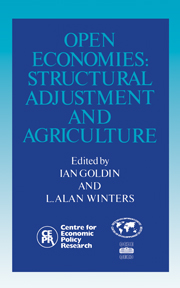Book contents
- Frontmatter
- Contents
- List of figures
- List of tables
- Preface
- Acknowledgements
- List of conference participants
- 1 Introduction: from macro to maize
- Part One Open economy analysis
- Part Two The small country assumption and trade reform
- Part Three Risk and adjustment
- 9 Markets, stabilisation and structural adjustment in Eastern European agriculture
- Discussion
- 10 Should marketing boards stabilise prices through forward purchases?
- Discussion
- Part Four Government's role
- Index
Discussion
from Part Three - Risk and adjustment
Published online by Cambridge University Press: 04 August 2010
- Frontmatter
- Contents
- List of figures
- List of tables
- Preface
- Acknowledgements
- List of conference participants
- 1 Introduction: from macro to maize
- Part One Open economy analysis
- Part Two The small country assumption and trade reform
- Part Three Risk and adjustment
- 9 Markets, stabilisation and structural adjustment in Eastern European agriculture
- Discussion
- 10 Should marketing boards stabilise prices through forward purchases?
- Discussion
- Part Four Government's role
- Index
Summary
Chapter 9 begins with a clear, objective perspective on the problem of agricultural adjustment in Eastern Europe. The authors describe the need to move from massive disequilibrium under planning toward a market economy while, at the same time, satisfying desires for stability. The path is uncertain in ways that are external to the participants and very different from the ones usually encountered in agricultural markets. The destination – the ultimate level of equilibrium market prices and outputs – is not known.
The authors attempt to evaluate various approaches to stabilizing agricultural prices and incomes by:
– trade tools, such as variable import and export tariffs
– domestic stabilisation programmes, and
– market-based risk contracts – futures markets.
Their evaluation is based on three criteria:
– effectiveness as stabilisers
– facilitating (or impeding) the adjustment
– creation of new private enterprise institutions.
I remain uncertain which of these objectives comes first. The authors make many judgements which imply that the last criterion plays a most important role in their appraisals.
Sometimes a look at the real world is exceedingly revealing. That is certainly true in this case. This study includes a comparison of what happened in Hungary and in Poland: the contrast is striking. Whereas Hungary has developed a futures market, like that in Chicago, it accounts for only a very small fraction of trade, it does not do much to stabilise prices, and provides little hedging. In Poland, on the other hand, a government agency has been set up. It has provided a large volume of forward contracts, these are not hedged, and they do not appear to be enforced.
- Type
- Chapter
- Information
- Open EconomiesStructural Adjustment and Agriculture, pp. 219 - 221Publisher: Cambridge University PressPrint publication year: 1992
- 1
- Cited by



